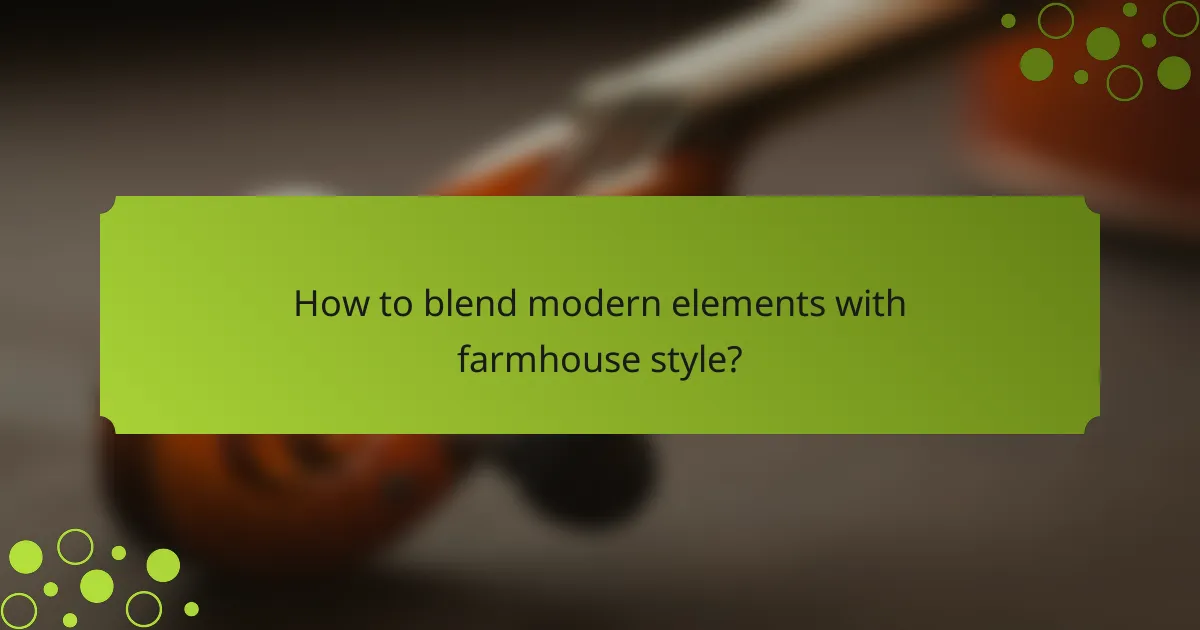Farmhouse design beautifully blends rustic charm with practicality, creating warm and inviting spaces that celebrate natural materials and vintage accents. By focusing on open layouts and multi-purpose furniture, these homes maximize comfort while showcasing character through elements like barn doors and antique fixtures. Embracing simplicity and aged items, farmhouse aesthetics evoke the essence of country living, making them both functional and visually appealing.

How to achieve rustic charm in farmhouse design?
To achieve rustic charm in farmhouse design, focus on natural materials, vintage elements, and a warm, inviting atmosphere. This style emphasizes simplicity and practicality while celebrating the beauty of aged and reclaimed items.
Use reclaimed wood accents
Incorporating reclaimed wood accents is essential for creating a rustic farmhouse feel. Consider using salvaged barn wood for beams, flooring, or furniture pieces. This not only adds character but also promotes sustainability.
When selecting reclaimed wood, look for pieces with a weathered finish and unique grain patterns. These features enhance the rustic aesthetic and can be used in various applications, from accent walls to custom cabinetry.
Incorporate vintage furniture
Vintage furniture plays a crucial role in achieving a farmhouse’s rustic charm. Seek out pieces from flea markets, estate sales, or antique shops that showcase craftsmanship and history. Items like distressed tables, mismatched chairs, and vintage cabinets can add warmth and personality to your space.
Mixing different styles and eras can create an eclectic yet cohesive look. Aim for a balance between comfort and style, ensuring that each piece is functional while contributing to the overall rustic theme.
Choose warm color palettes
A warm color palette is vital for establishing a cozy farmhouse atmosphere. Opt for earthy tones such as soft browns, muted greens, and warm whites. These colors evoke a sense of nature and tranquility, enhancing the rustic charm of your design.
Consider using these colors on walls, furniture, and decor. Accent with deeper shades to create contrast and depth, ensuring a harmonious blend that feels inviting and lived-in. Natural light can further enhance these tones, so maximize window space to let in sunlight.

What are practical layout tips for farmhouse design?
Practical layout tips for farmhouse design focus on creating an inviting and functional space that maximizes comfort and utility. Key strategies include open floor plans, designated functional zones, and the use of multi-purpose furniture to enhance both aesthetics and livability.
Open floor plans for spaciousness
Open floor plans are a hallmark of farmhouse design, promoting a sense of spaciousness and flow between living areas. By removing unnecessary walls, you create a seamless transition from the kitchen to the dining and living spaces, which is ideal for family gatherings and entertaining.
Consider using large islands or breakfast bars to define areas within the open space while still maintaining an airy feel. This layout not only enhances social interaction but also allows natural light to permeate throughout the home, making it feel more inviting.
Designate functional zones
Designating functional zones within an open layout helps organize the space effectively. Identify areas for cooking, dining, and relaxing, ensuring each zone serves its purpose without clutter. Use rugs, furniture placement, or even decorative screens to visually separate these areas.
For instance, a cozy reading nook can be created with a comfortable chair and a small side table, while the dining area can be defined by a larger table and distinct lighting. This approach maintains the farmhouse’s charm while enhancing usability.
Utilize multi-purpose furniture
Multi-purpose furniture is essential in farmhouse design, especially in smaller spaces. Look for items that can serve dual functions, such as a coffee table with storage or a sofa bed for guests. This not only saves space but also adds versatility to your home.
Incorporating furniture that can be easily rearranged or expanded, like extendable dining tables, allows for flexibility during gatherings. When selecting pieces, prioritize durability and style to ensure they complement the rustic charm of your farmhouse while being practical for everyday use.

Which vintage accents enhance farmhouse aesthetics?
Vintage accents play a crucial role in enhancing farmhouse aesthetics by adding character and warmth. Key elements like barn doors, antique lighting fixtures, and farmhouse sinks can create a rustic yet practical atmosphere that embodies the charm of country living.
Install barn doors
Barn doors are a quintessential element of farmhouse design, offering both functionality and style. They can serve as room dividers or closet doors, saving space while adding a rustic touch. Consider using reclaimed wood for an authentic look, and ensure the hardware is sturdy enough to support the door’s weight.
When selecting barn doors, think about the finish. A weathered look can enhance the vintage appeal, while a fresh coat of paint can modernize the design. Measure your door frame carefully to ensure a perfect fit and smooth operation.
Add antique lighting fixtures
Antique lighting fixtures are essential for creating a warm and inviting atmosphere in a farmhouse. Look for chandeliers, pendant lights, or sconces that feature materials like wrought iron or aged brass. These fixtures not only illuminate spaces but also serve as focal points that draw the eye.
When choosing lighting, consider the size of the room and the height of the ceilings. A large chandelier can make a statement in a dining area, while smaller sconces work well in hallways. Ensure that the fixtures are compatible with modern bulbs for energy efficiency.
Incorporate farmhouse sinks
Farmhouse sinks, also known as apron sinks, are a practical and stylish addition to any kitchen. Their deep basins make them ideal for washing large pots and pans, while their design adds a vintage flair. Materials like porcelain or fireclay are popular choices for durability and aesthetic appeal.
When installing a farmhouse sink, ensure that your cabinetry can support its weight and dimensions. Pair it with a vintage-style faucet to complete the look. Consider the overall kitchen layout to ensure that the sink is both functional and visually appealing.

What are the best materials for farmhouse design?
The best materials for farmhouse design combine rustic charm with practical functionality. Prioritize natural elements that enhance durability and aesthetic appeal while ensuring comfort and ease of maintenance.
Natural stone for durability
Natural stone is a top choice for farmhouse design due to its strength and timeless appeal. Options like granite, slate, and limestone not only provide a sturdy foundation but also add a rustic character to spaces.
When selecting stone, consider its finish and color to complement your overall design. For example, lighter stones can brighten a space, while darker options can create a cozy atmosphere. Ensure proper sealing to protect against moisture and stains.
Metal accents for contrast
Incorporating metal accents into farmhouse design adds a contemporary touch that contrasts beautifully with natural materials. Common choices include wrought iron, galvanized steel, and copper, which can be used in fixtures, railings, and decorative elements.
Choose finishes that match the overall theme; for instance, matte black or brushed nickel can enhance a modern farmhouse look, while aged copper can evoke a vintage feel. Be mindful of rust and corrosion, particularly in humid areas, and select treated metals where necessary.
Textiles like linen and burlap
Textiles such as linen and burlap contribute warmth and texture to farmhouse interiors. These materials are not only durable but also bring a natural, inviting feel to spaces.
Use linen for curtains, cushions, and upholstery to create a soft, breathable environment. Burlap can be utilized in table runners, wall hangings, or as accents in decor. Ensure that these fabrics are easy to clean and maintain, especially in high-traffic areas.

How to blend modern elements with farmhouse style?
Blending modern elements with farmhouse style involves integrating sleek designs and contemporary aesthetics while maintaining the rustic charm of traditional farmhouses. Focus on using clean lines, functional layouts, and curated decor to create a harmonious balance.
Use sleek appliances
Sleek appliances can enhance the functionality of a farmhouse kitchen while adding a modern touch. Opt for stainless steel or matte finishes that complement rustic wood cabinetry and vintage accents. Consider energy-efficient models that not only look good but also reduce utility costs.
When selecting appliances, prioritize those with smart technology features. These can simplify daily tasks and improve convenience without sacrificing the farmhouse aesthetic.
Incorporate minimalist decor
Minimalist decor emphasizes simplicity and functionality, making it a perfect match for farmhouse style. Choose a few key decorative pieces that reflect your personality while avoiding clutter. Neutral color palettes, natural materials, and open spaces can help achieve this look.
For example, consider using a single statement piece, like a large, framed mirror or a unique light fixture, to draw attention without overwhelming the space. This approach allows the rustic elements to shine through while keeping the overall design fresh and modern.
Choose contemporary art pieces
Contemporary art can serve as a striking contrast to traditional farmhouse elements, adding a modern flair. Select pieces that resonate with your style and complement the color scheme of your home. Abstract paintings or minimalist sculptures can create focal points in living areas.
When integrating art, think about scale and placement. Large pieces can anchor a room, while smaller works can be grouped for visual interest. Ensure that the art aligns with the overall theme, enhancing the rustic charm rather than clashing with it.

What are the key features of Australian farmhouse design?
Australian farmhouse design is characterized by its rustic charm, practical layouts, and vintage accents. Key features include spacious living areas, wide verandas, and a blend of natural materials that create a warm, inviting atmosphere.
Wide verandas for outdoor living
Wide verandas are a hallmark of Australian farmhouse design, providing essential outdoor living space that enhances the home’s functionality. These areas are ideal for relaxing, entertaining, and enjoying the surrounding landscape, often featuring comfortable seating and dining options.
When designing a veranda, consider the orientation to maximize sunlight and shade throughout the day. A well-placed veranda can significantly improve the comfort of your home, allowing for year-round outdoor enjoyment. Incorporating elements like ceiling fans or outdoor heaters can extend usability into the cooler months.
Common materials for verandas include timber and metal, which complement the rustic aesthetic. Ensure that the design aligns with local building regulations, particularly regarding safety and structural integrity, to create a safe and enjoyable outdoor space.
